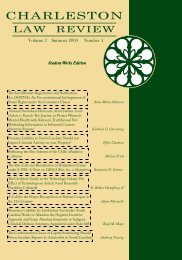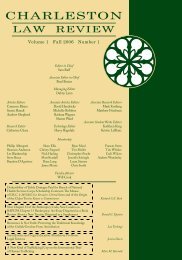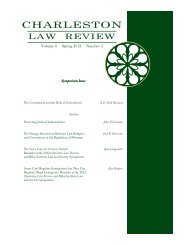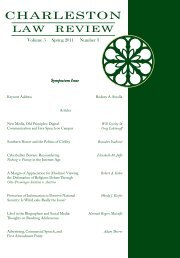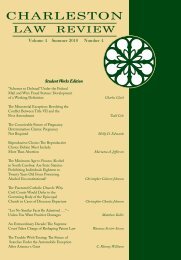Volume 5 Winter 2011 Number 2 - Charleston Law Review
Volume 5 Winter 2011 Number 2 - Charleston Law Review
Volume 5 Winter 2011 Number 2 - Charleston Law Review
Create successful ePaper yourself
Turn your PDF publications into a flip-book with our unique Google optimized e-Paper software.
SCHULZE FINAL.doc1/20/<strong>2011</strong> 6:14PMCHARLESTON LAW REVIEW [<strong>Volume</strong> 5This theory translates to legal education in a meaningfulway. Students often come to law school thinking that they willlearn “the laws,” perhaps in some sequential order of importance.They are soon dismayed when their syllabi direct them tocomplete tasks seemingly unconnected with the goal of learningdescriptive definitions of each law. The student that thinks hewill learn “what the law is” is frequently disoriented by a flood oftasks focused more on rewiring the student’s analyticalmethodology. Thus, many students in the first semester find themajority of law school tasks to be inconsistent with what theythought they needed to learn to practice law. They may ask:“Why read this case about a contract from 1889 when I could justwould recommend explicitly explaining this process to students to demystify thelearning process, create greater learning motivation, and engage students to bemore cognizant of their mission. See Zimmerman, supra, at 909 (recommendinginstruction which promotes a feeling of connectivity between law students andtheir work to cultivate intrinsic motivation); Lustbader, supra note 14, at 844(arguing that ASP faculty work “to help students retain a sense of self-worthand to demystify the learning process”).Professors set in their ways might posit two objections. First, with allthe material on the first-year agenda, how can doctrinal professors possiblydevote time to something which, for decades, has been left to students’ implicitlearning? See Bloom & Schulze, supra note 43, at 14–16 (discussing challengesto getting faculty on board with integrated learning). See Jacobson, supra note78, at 900–05 (noting the external and internal influences contributing to thelack of change within law school pedagogy). That answer leads to the thesis ofthis Article: Instead of having doctrinal professors change their ways, simplyinclude an ASP whose central purpose is to demystify the process of learninglaw.Second, what of the age-old tradition of law student selfenlightenment?See Lloyd, supra note 87, at 677 (arguing that law schools havebeen shifting away from “hard” law school teaching methods). Should weabandon the project of forcing students to teach themselves of the macroorganizationof law school learning? Should they not figure out for themselvesthe nature of law school pedagogy? Should we spoon-feed this generation,because understanding the big picture is just too in-depth for such a “give-mewhat-I-need-now”generation? The answer is “no.” See id. at 681–84; Ruta K.Stropus, Mend It, Bend It, and Extend It: The Fate of Traditional <strong>Law</strong> SchoolMethodology in the 21st Century, 27 LOY. U.CHI. L.J. 449, 487 (1996). I am notsuggesting that we reduce all legal learning to lectures on what the law “is.”What I suggest is that instead of playing a strict game of pretending thatnothing in law school is all that different from other learning, we give studentsthe tools to unravel this mysterious new learning method. SDT and autonomysupport would provide a sensible middle ground in this respect, which isdiscussed next.302



